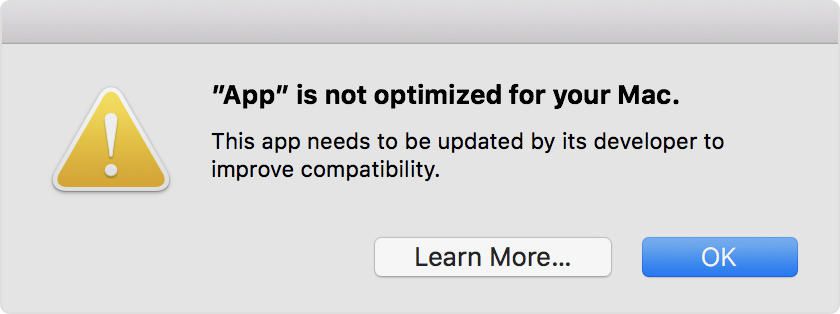
Heard the news? 32-bit is dead.
Apple has been working on phasing out 32-bit apps for more than a decade, for several valid reasons, ranging from security issues, to slow execution, and everything in between.
64-bit applications, no matter whether you are a Mac, Linux, or Windows user, possess several advantages, as earlier noted, over 32-bit apps, in the same way 32-bit programs were superior to 16-bit applications back in the 90s.
64-bit applications, no matter whether you are a Mac, Linux, or Windows user, possess several advantages, as earlier noted, over 32-bit apps, in the same way 32-bit programs were superior to 16-bit applications back in the 90s.
Just like then, Apple is now boosting its stance to end 32-bit support, this time by means of pop-up messages warning users that the apps they are running are not optimized for their Macs.
Of course, Apple Mac OS High Sierra will still run 32-bit apps, rather than block their execution altogether, but this also means that stability and reliability of these apps will be no longer a guarantee, as Apple moves onto 64-bit apps, leaving the antiquated architecture in the dust.
The messages have began appearing as of the latest High Sierra update, 10.13.4, released two weeks ago.
Mac OS is the last remaining operating system by Apple, where 32-bit apps can run, as iOS WatchOS and tvOS are all running exclusively 64-bit code.
Possible issues that may manifest in future Mac updates, could impact more than just the look and feel of applications within the Mac ecosystem. 32-bit applications represent a weak link in any 64-bit system where they are not properly isolated within sandbox-like memory locations, in a similar way as what Windows 10 does with all of its applications, regardless of their architecture. This means that 32-bit apps could be exploited in the future, to gain access to systems, in a similar way as Java was once used to hack into Windows PCs, through not extinct versions of Adobe Flash Player. Weaker code creates openings for serious malware such as Ransomware,which can penetrate any system where special conditions are created to let older programs run, such as in the case of emulator programs.
If your favorite app has not been ported to 64-bit yet, and you are worried for the safety of your system, there are other ways to run 32-bit apps, other than natively from within Mac OS High Sierra. For instance, using virtual machine environments, lets you run any application within a well-isolated sandbox that keeps everything within and separate from the rest of the operating system.
Using Parallels to install a separate instance of Mac OS is also an ideal way to run older apps without causing your main environment to be compromised, should that be a concern.
Ready to shop?
Looking for the most powerful desktop created by Apple? PortableOne is where you can buy the All-New Apple iMac Pro a production powerhouse for high-end creative professionals, with endless possibilities, and unprecedented specs.